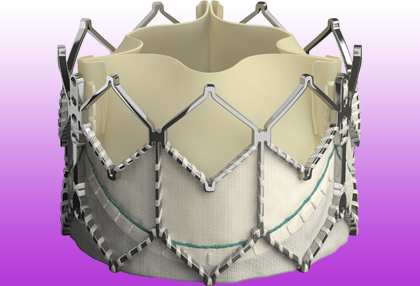
This study involved 70 consecutive patients who underwent transcatheter aortic valve replacement with the Edwards SAPIEN-XT device and were subjected to follow-up at 6 months and 1 year through multislice computed tomography (CT), echocardiographic data, and laboratory findings.
As regards the whole cohort, CT scans revealed hypoattenuated thickening in 1 patient (1.4%) at discharge, 7 (10.0%) at 6 months, and 10 (14.3%) at 1 year after the procedure.
The degree of leaflet immobility was well-correlated with the hypoattenuated thickening area as measured through a CT scan (r = 0.68).
Thickening was associated with male sex (70% vs. 25%; p = 0.008) and larger sinus of Valsalva (31.0 ± 2.0 mm vs. 28.6 ± 2.6 mm; p = 0.005).
Thickening was found in 3 of 49 patients with a 23-mm valve and in 7 of 21 patients with a 26-mm valve (6.1% vs. 33.3%; p = 0,006).
As expected, D-dimer levels were significantly increased in the group whose CT scans showed thickening, both at 6 months (2.3 mg/mL vs. 1.1 mg/mL; p = 0.002) and at 1 year (2.7 mg/mL vs. 1.2 mg/mL; p = 0.006). These differences in D-dimer levels were not present at discharge.
After obtaining these scans, additional action, such as anticoagulation therapy, was not taken. Despite all of the above, events such as all-cause death or stroke were similar between groups.
Conclusion
Hypoattenuated leaflet thickening is relatively frequent but usually subclinical. Gradients through valve and clinical events were not significantly modified, even without active action such as anticoagulant therapy.
Male sex, bioprosthesis size, sinus size, and D-dimer levels were associated with this phenomenon.
Editorial
This study coincided with the work of a research group led by Nicolaj C. Hansson in points such as low frequency of clinical expression and the association between this phenomenon and larger valves. In the study by Dr. Nicolaj C. Hansson, treatment with warfarin effectively reverted valve thrombosis in 85% of patients, as shown by follow-up transesophageal echocardiography and multislice computed tomography.
However, upon evidence of few clinical consequences derived from this phenomenon, and assuming that most patients undergoing transcatheter aortic valve replacement are elderly and present a high risk of bleeding, the decision to apply anticoagulant therapy must be taken while exercising extreme caution.
Original title: Incidence, Predictors, and Mid-Term Outcomes of Possible Leaflet Thrombosis After TAVR.
Reference: Ryo Yanagisawa et al. JACC Cardiovasc Imaging. [Epub ahead of print].
Subscribe to our weekly newsletter
Get the latest scientific articles on interventional cardiology
We are interested in your opinion. Please, leave your comments, thoughts, questions, etc., below. They will be most welcome.





